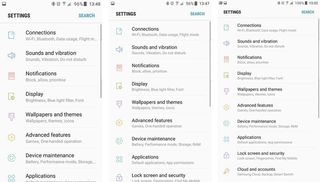Galaxy S7 on Nougat defaults to 1080p: A look at Samsung's new display scaling options

Android 7.0 Nougat for the Samsung Galaxy S7 — currently in testing in the form of a semi-public beta build — is the phone's biggest software update to date, featuring not only a brand new OS version, but a host of new Samsung-specific changes, and a significantly updated UI. Among them are major changes to the display settings, allowing you to change how graphics and fonts are shown — and change the phone's screen resolution.
This feature isn't entirely new. The GS7 has offered a "condensed mode" for a while, and the ill-fated Note 7 let you reduce the screen resolution as a battery-saving measure. On the GS7 on Nougat, however, the option is presented less as a last-ditch battery-saving feature, and more as a thing you just set and leave on.
Your three options are HD (720p), Full HD (1080p) and Quad HD (1440p). And whereas before the native 1440p resolution was the default, now it's 1080p.
Wait... what?
Yep. A clean installation of the current Nougat beta on the Galaxy S7 and S7 edge has both phones running below their native screen resolution. This comes along with the standard disclaimers about the current build being a beta, and things possibly changing when the official OTA rolls out. (It's entirely possible Samsung may vary this setting from region to region, too — Chinese characters, for instance, would benefit from the additional clarity that 1440p brings.)
A subtle visual downgrade for subtle performance and battery improvements.
But as bizarre as this move might seem, there's a method to Samsung's madness. Most of the time, you just can't tell the difference between Full HD and Quad HD anyway. And bumping down to 1080p can bring performance and battery life improvements. Not huge improvements to be sure — we haven't noticed significantly lengthened battery life in the past couple of days in 1080p mode. Other things like display brightness, CPU load and signal strength play a much greater part. Nevertheless, it's a factor.
And it speaks to something many of us know, deep down: Quad HD resolution is, for the most part, wasted on a device with a 5- to 5.5-inch display.
Get the top Black Friday deals right in your inbox: Sign up now!
Receive the hottest deals and product recommendations alongside the biggest tech news from the Android Central team straight to your inbox!
Naturally, downscaling all the way to 720p makes the display noticeable more pixellated, with some UI elements having to be juggled around to compensate for the lower pixel density.

On the 5.5-inch GS7 edge, the difference is only barely noticeable, when examining text and fine details in photos up close. On the 5.1-inch GS7, the argument for defaulting to 1080p is even more compelling. In both cases, we'd imagine the Gear VR would still be able to use the displays' full resolution, however VR isn't supported in the current Nougat beta.
Changing the resolution doesn't affect the size of things on the display — that's controlled by a separate setting called "screen zoom." Nor does it seem to affect memory consumption — the amount of RAM consumed by the system with no apps running in the foreground didn't change notably when switching between resolutions. We also didn't notice any major performance differences in the system UI and day-to-day apps like Chrome, Twitter, Instagram, Hangouts, WhatsApp and the like. (Games will be more sensitive to screen resolution changes, but many titles already offer in-game resolution sliders.) As always, your mileage may vary.

Could we see similar resolution options built into a 4K-capable Galaxy S8?
The default screen zoom level has everything looking a bit oversized, at least to my eye. Stepping down to the "tiny" zoom level (roughly equivalent to the old Condensed Mode on Marshmallow) shows more on screen. "Huge" mode scales things up significantly, showing less on the screen, and may be more legible for GS7 owners with vision problems when combined with a larger font size.
This is a natural extension of the display scaling features Google has built into Android 7.0, and it's interesting to see Samsung developing things further by offering control over display resolution, as well as the density of the UI.
It's easy to see how these features could be further built out in Samsung's next flagships, the Galaxy S8 line. If, as rumored, one of these phones has a 4K-capable screen, it's likely the phone wouldn't run in 4K mode all the time, but instead scale down to 1440p or even 1080p in day-to-day app use. (The first mainstream 4K phone, the Sony Xperia Z5 Premium, already does this without any user-facing settings.)
In any case, it's good to have options. Be sure to hit the comments and let us know which resolution you'll choose when the GS7 Nougat update hits.

Alex was with Android Central for over a decade, producing written and video content for the site, and served as global Executive Editor from 2016 to 2022.